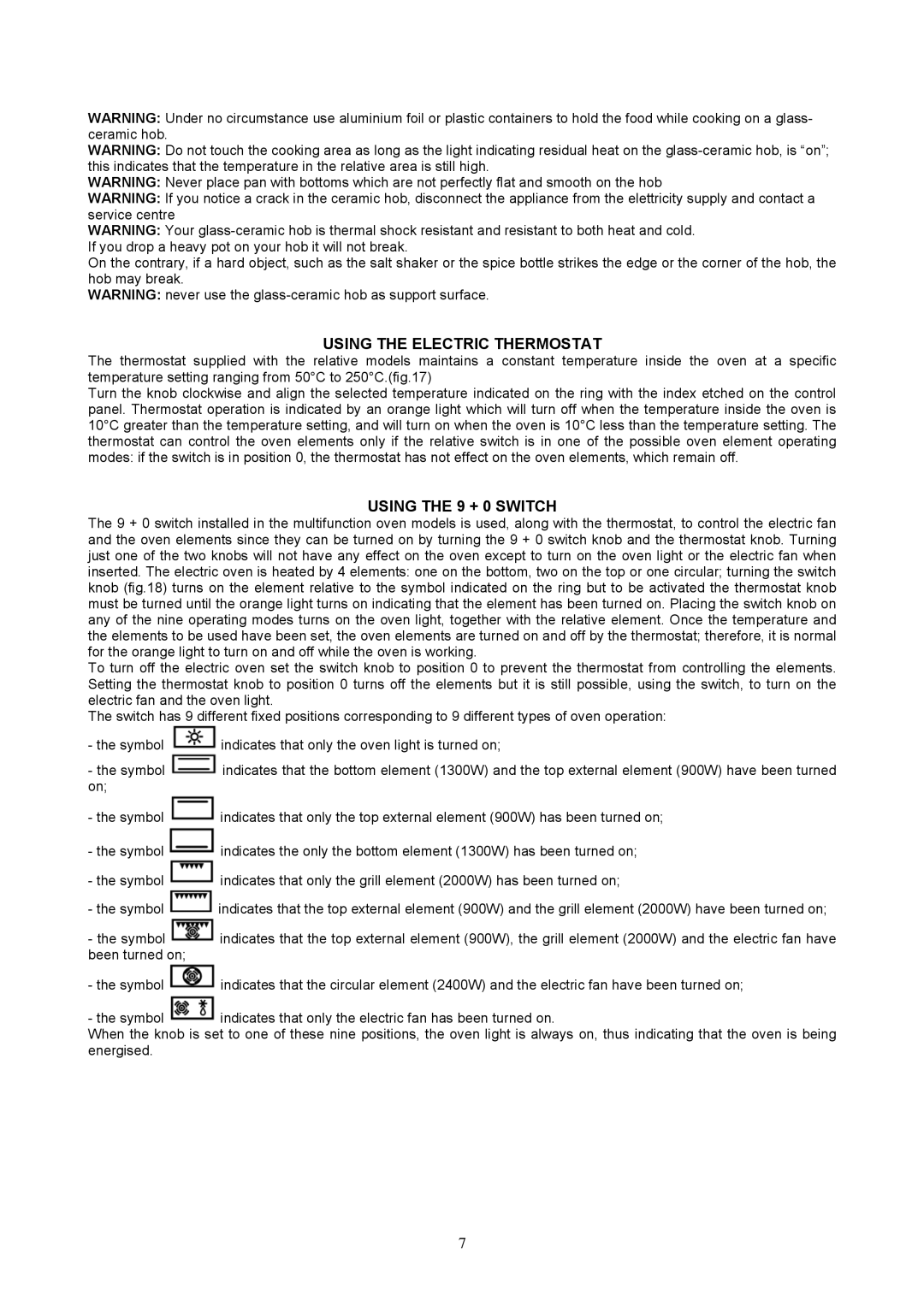WARNING: Under no circumstance use aluminium foil or plastic containers to hold the food while cooking on a glass- ceramic hob.
WARNING: Do not touch the cooking area as long as the light indicating residual heat on the
WARNING: Never place pan with bottoms which are not perfectly flat and smooth on the hob
WARNING: If you notice a crack in the ceramic hob, disconnect the appliance from the elettricity supply and contact a service centre
WARNING: Your
On the contrary, if a hard object, such as the salt shaker or the spice bottle strikes the edge or the corner of the hob, the hob may break.
WARNING: never use the
USING THE ELECTRIC THERMOSTAT
The thermostat supplied with the relative models maintains a constant temperature inside the oven at a specific temperature setting ranging from 50°C to 250°C.(fig.17)
Turn the knob clockwise and align the selected temperature indicated on the ring with the index etched on the control panel. Thermostat operation is indicated by an orange light which will turn off when the temperature inside the oven is 10°C greater than the temperature setting, and will turn on when the oven is 10°C less than the temperature setting. The thermostat can control the oven elements only if the relative switch is in one of the possible oven element operating modes: if the switch is in position 0, the thermostat has not effect on the oven elements, which remain off.
USING THE 9 + 0 SWITCH
The 9 + 0 switch installed in the multifunction oven models is used, along with the thermostat, to control the electric fan and the oven elements since they can be turned on by turning the 9 + 0 switch knob and the thermostat knob. Turning just one of the two knobs will not have any effect on the oven except to turn on the oven light or the electric fan when inserted. The electric oven is heated by 4 elements: one on the bottom, two on the top or one circular; turning the switch knob (fig.18) turns on the element relative to the symbol indicated on the ring but to be activated the thermostat knob must be turned until the orange light turns on indicating that the element has been turned on. Placing the switch knob on any of the nine operating modes turns on the oven light, together with the relative element. Once the temperature and the elements to be used have been set, the oven elements are turned on and off by the thermostat; therefore, it is normal for the orange light to turn on and off while the oven is working.
To turn off the electric oven set the switch knob to position 0 to prevent the thermostat from controlling the elements. Setting the thermostat knob to position 0 turns off the elements but it is still possible, using the switch, to turn on the electric fan and the oven light.
The switch has 9 different fixed positions corresponding to 9 different types of oven operation:
-the symbol ![]() indicates that only the oven light is turned on;
indicates that only the oven light is turned on;
-the symbol ![]() indicates that the bottom element (1300W) and the top external element (900W) have been turned on;
indicates that the bottom element (1300W) and the top external element (900W) have been turned on;
-the symbol ![]() indicates that only the top external element (900W) has been turned on;
indicates that only the top external element (900W) has been turned on;
-the symbol ![]() indicates the only the bottom element (1300W) has been turned on;
indicates the only the bottom element (1300W) has been turned on;
-the symbol ![]() indicates that only the grill element (2000W) has been turned on;
indicates that only the grill element (2000W) has been turned on;
-the symbol ![]() indicates that the top external element (900W) and the grill element (2000W) have been turned on;
indicates that the top external element (900W) and the grill element (2000W) have been turned on;
-the symbol ![]() indicates that the top external element (900W), the grill element (2000W) and the electric fan have been turned on;
indicates that the top external element (900W), the grill element (2000W) and the electric fan have been turned on;
-the symbol ![]() indicates that the circular element (2400W) and the electric fan have been turned on;
indicates that the circular element (2400W) and the electric fan have been turned on;
-the symbol ![]() indicates that only the electric fan has been turned on.
indicates that only the electric fan has been turned on.
When the knob is set to one of these nine positions, the oven light is always on, thus indicating that the oven is being energised.
7
